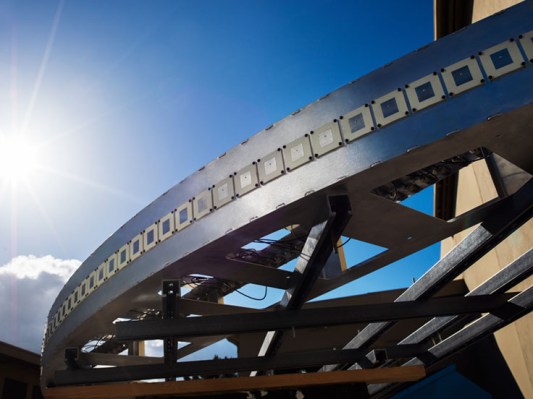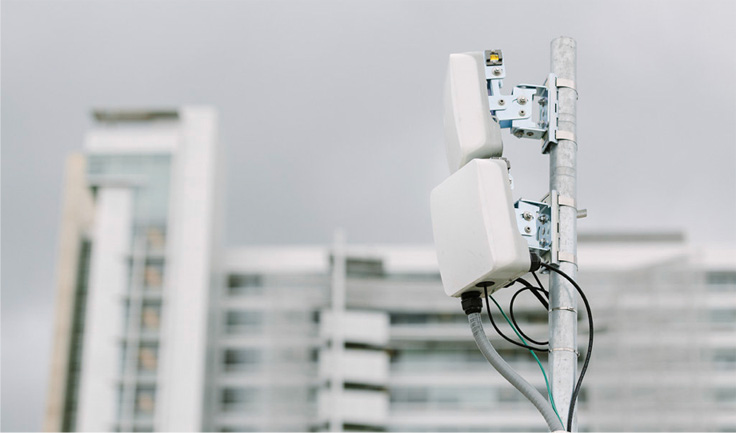Facebook has been putting a lot of resources into improving internet connectivity in rural areas. At first, that may seem like a distraction for the social networking giant, but Facebook takes its mission to connect people pretty literally. And to do so, it’s taking a building-block approach that involves lots of different projects that all attempt to solve different issues of this larger technology challenge.
At its F8 conference in San Jose this week, Facebook once again moved these connectivity efforts into the spotlight. While the most exciting example of its work in this area is surely its giant, solar-powered Aquila drone (which actually hangs over the exhibit area at the conference), a lot of the work Facebook is doing here is in the networking technologies that connect the drone (or multiple drones) with the internet. That includes a project like Terragraph, which is meant for urban environments, as well as the likes of the OpenCellular project, a fully featured wireless access platform of technologies for improving the backhaul networks that power all of this.
As Facebook’s director of its connectivity programs Yael Maguire told me in an interview at the event, it’s worth remembering that Facebook itself has no interest in commercializing these technologies. “There is technology development and then there’s the community — how we engage with the world,” he said. “As technology gets developed, the plan is to contribute it to community organizations, the Telecom Infrastructure Project — modeled after the Open Compute project — and then figure out how we get like-minded companies and individuals excited about thinking about how technology gets deployed at scale.” He noted that a number of telecom companies are already working on prototyping some of the technologies Facebook developed and contributed, including the Voyager router project.
Facebook’s projects, of course, focus on connecting rural areas that are currently underserved by exactly the telecom companies it hopes will adopt these technologies. As Maguire noted, what these telecoms care about is that the backhaul becomes price-effective enough that it makes sense for them to provide connectivity in these areas.
At the end of the day, all of these projects — no matter whether we are talking about drones or antennas that cover city blocks — depend on a backhaul network that is typically powered by fiber connections. That was also one of Facebook’s motivations for launching a rather traditional fiber network in Uganda earlier this year. “Fiber is the start of everything,” Maguire said. “You can’t have Aquila, you can’t have Terragraph unless you have fiber. And so we have to make sure that we are part of understanding and seeing if there is any way that we can help in the ecosystem context if every part of that chain of technology can work. And if Fiber is hard to deploy in rural Uganda to connect Aquila, then we have a problem.”
It’s worth noting that for Facebook, the emphasis here is on connecting people — not devices. So while the projects it is working on may also be useful for Internet-of-Things (IoT) applications, that’s not something the company is focusing on itself. Maguire noted that the openness of the project does mean that others can take these technologies and apply them to IoT.
Now that Facebook has many of the hardware building blocks in place, one of the next major set of challenges involves the software that brings it all together. “That’s actually where we are really excited because that really plays to the core strengths of the company,” Maguire told me. “We started as a software company. We’ve gotten really good at combining software and hardware for our infrastructure and that was about taking a lot of things that were commodity hardware and bringing them together in unique ways. So this idea of taking building blocks and combining them is not foreign to us.”
Facebook, of course, isn’t the only company working on solving this issue of bringing connectivity to rural areas. When I asked Maguire about Google’s project Loon, which uses balloons instead of drones, he noted that his team is cheering for Google to succeed, too. “Connecting people just helps everyone, I think,” he said. “I love that they are exploring different spaces than we are.” Maguire, however, also noted that his team didn’t choose the balloon approach for a reason. “We want to focus on systems that can station-keep,” he said. “If you are connected to this network, we want to make sure that you have connectivity at all times. If the wind is blowing, it has to be there. […] At low altitude, we want systems to be tethered and we want to make it so that there is propulsion so that in the face of winds they stay stationary to provide that connectivity.”

